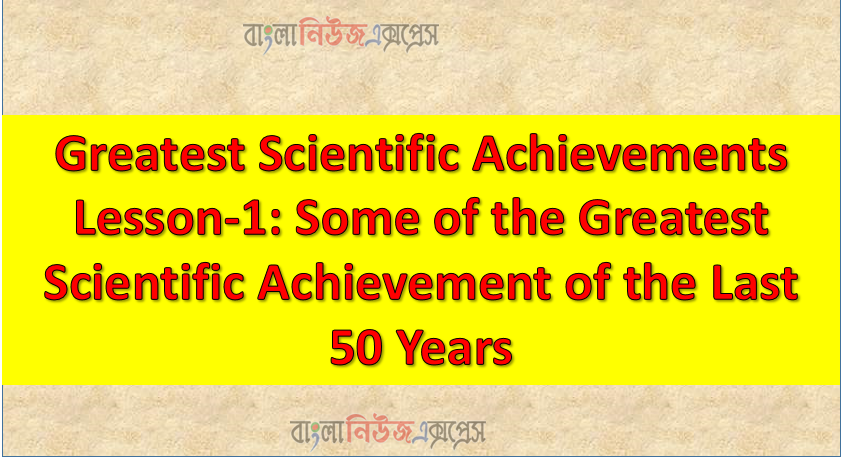Unit-13: Greatest Scientific Achievements
Lesson-1: Some of the Greatest Scientific Achievement of the Last 50 Years
- Covid-19 is currently the focus of attention all over the world. The disease, caused by the novel corona virus has been unfolded worldwide. The whole world is watching to see when the cure for this disease will come.
How can the invention of the corona virus drug or vaccine be invented by the scientists of the world to get rid mankind from this terrible virus? Elaborate it within 100 words.
Ans:
- An innovative approach to COVID-19 vaccine development using RNA offers advantages in speed and scalability, if tests prove successful.
- Although effective vaccines may be identified in 12 to 18 months, it could take significantly longer before they become globally available.
- The world must learn from the COVID-19 pandemic and ensure sufficient investment is made to safeguard against future pandemics.
Work to fast-track the development of a coronavirus vaccine received a boost last week as the UK government announced £42.5 million in funding for the country’s two leading efforts at Oxford University and Imperial College London. Last Thursday, Oxford University’s programme, led by Professor Sarah Gilbert, became Europe’s first to enter human trials while the Imperial College team aim to begin clinical trials in June. This takes the total number of coronavirus vaccine clinical trials started in 2020 to 11.
- Efficacy: The benefit that a vaccine provides compared to a placebo, as measured in a clinical trial. To test a coronavirus vaccine, for instance, researchers compare how many people in the vaccinated and placebo groups get Covid-19. Effectiveness, by contrast, is the benefit that a vaccine or a drug provides out in the real world. A vaccine’s effectiveness may turn out to be lower or higher than its efficacy.
- Phase 1, 2, and 3 trials: Clinical trials typically take place in three stages. Phase 1 trials usually involve a few dozen people and are designed to observe whether a vaccine or drug is safe. Phase 2 trials, involving hundreds of people, allow researchers to try out different doses and gather more measurements about the vaccine’s effects on the immune system. Phase 3 trials, involving thousands or tens of thousands of volunteers, determine the safety and efficacy of the vaccine or drug by waiting to see how many people are protected from the disease it’s designed to fight.
- Placebo: A substance that has no therapeutic effect, often used in a clinical trial. To see if a vaccine can prevent Covid-19, for example, researchers may inject the vaccine into half of their volunteers, while the other half get a placebo of salt water. They can then compare how many people in each group get infected.
- Post-market surveillance: The monitoring that takes place after a vaccine or drug has been approved and is regularly prescribed by doctors. This surveillance typically confirms that the treatment is safe. On rare occasions, it detects side effects in certain groups of people that were missed during clinical trials.
- Preclinical research: Studies that take place before the start of a clinical trial, typically involving experiments where a treatment is tested on cells or in animals.
Assignment
- HSC (BM) Assignment Answer in English 1812
- English Assignment 2
- Part-A (Unit Twelve): Lesson – 2 What is conflict?
- এ্যাসাইনমেন্টের মাধ্যমে এইচএসসি (বিএম-ভোক) ও ডিপ্লোমা ইন কমার্স শিক্ষাক্রম এর একাদশ শ্রেণির বোর্ড চূড়ান্ত পরীক্ষা-২০২০ এর ফলাফল প্রক্রিয়াকরণ
- Diploma in Commerce- ইংরেজি এসাইনমেন্ট উত্তর
- এইচএসসি বিএম/Diploma in Commerce/এইচএসসি ভোকেশনাল Assignment, Information, Direction _ Routine অ্যাসাইনমেন্ট প্রশ্ন
- এইচএসসি ভোকেশনাল Assignment, Information, Direction _ Routine অ্যাসাইনমেন্ট প্রশ্ন
- এইচএসসি ভোকেশনাল বাংলা ১ম ৮১১১১ অ্যাসাইনমেন্ট প্রশ্ন
- এইচএসসি ভোকেশনাল ইংরেজি১ম অ্যাসাইনমেন্ট প্রশ্ন
- এইচএসসি বিএম Assignment, Information, Direction _ Routine অ্যাসাইনমেন্ট প্রশ্ন
- এইচএসসি বিএম ইংরেজি১ম অ্যাসাইনমেন্ট প্রশ্ন
- এইচএসসি বিএম বাংলা ১ম অ্যাসাইনমেন্ট প্রশ্ন
- Diploma in Commerce Assignment, Information, Direction _ Routine অ্যাসাইনমেন্ট প্রশ্ন
- এইচএসসি ডিপ্লোমা ইন কমার্স ইংরেজি- ১ম অ্যাসাইনমেন্ট প্রশ্ন
- এইচএসসি ডিপ্লোমা ইন কমার্স বাংলা ১ম অ্যাসাইনমেন্ট প্রশ্ন






